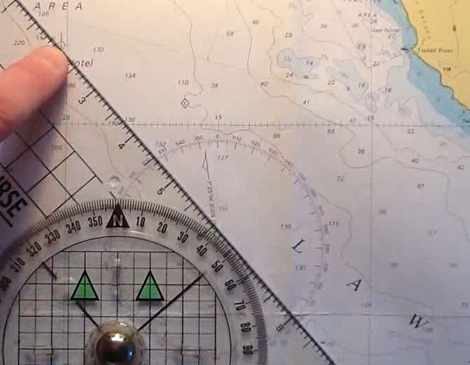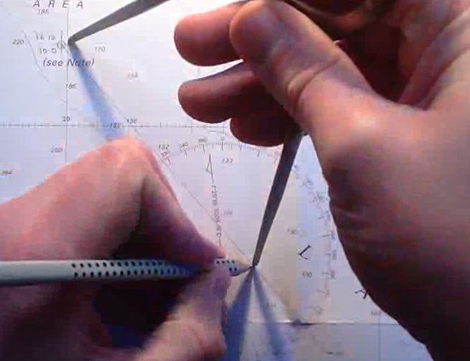Preparation
Before reading this page you will need to have a copy of the training almanac and chart (and a real one if possible).
You will need to be happy converting between magnetic and true north and understand the principals of leeway.
Why is this important?
If you are out of sight of land and you don’t have a GPS this is the simplest way of finding your approximate position (note: unlike Estimated Position it does not take into account the tide acting on you). It is also the least accurate method of finding your position but it is a good starting point.
Calculation of a DR
You need to know your initial position, the direction you are travelling and the distance you have travelled.
The best way to explain is through an example. At 16:10 we start our journey at a known location, 46o 11.8’N 006o 20.2’W and we start sailing on a course of 146oM.
At 16:10 the log (distance measuring device) reads 10.0Nm an hour later it reads 16.5Nm. We have therefore travelled 6.5Nm in one hour.
We use this information to find our position at 17:10. We start by plotting our initial position.
Now we take the direction travelled and convert this to a True bearing. If we needed to make an adjustment for deviation (Yachtmaster course only) we would do that first (we will skip this stage here). Then if variation is 7oW then we subtract 7o from 146o to get 139oT. We now draw a line from the initial position in this direction.
We now measure 6.5Nm from our initial position along this line which gives us our Dead Reckoning Position.
To see the whole method explained watch this video.
Video: skill
Allowing for leeway
If you are unsure what is meant by Leeway, see the Leeway page for more explanation.
We must remember that you need to apply to the heading once you have first allowed for Deviation and Variation ie.
Course Steered ± Deviation ± Variation ± Leeway = Water Track (T)
Note: if you are doing the Dayskipper course you can miss out Deviation.
The effect of leeway will always push your vessel downwind and therefore it is useful to draw a wind arrow on the chart and imagine the effect of the vessel being blown downwind. You can then establish whether the leeway should be added or subtracted from your heading.
For DR the rule is:
– Wind coming from Starboard – Subtract
– Wind coming from Port – Add (Plus)
Note: this is the opposite to CTS
Apart from changing the direction of travel the method for finding the DR is unchanged.
In this case using the example above, if we start sailing on a course of 139oT (as in the example above) in a south-westerly wind and allow 10o for leeway the boat is estimated to travels on 129oT.
To see this explained watch this video.
Video: skill
Links
Check your understanding

Check your knowledge of the basics using this quick self-marking test.
Open the quiz
Progression
If you are happy with the method above improve the accuracy of you position by calculating the Estimated Position which is DR with the tidal stream added on.
Feedback
The content of these pages is put together in good faith and is constantly evolving. It is possible that errors exist within this content. If you spot an error or would like to add anything to these pages please contact use via email.
Reading the content of these pages is not a substitute for completing a RYA Shorebased course or similar.



